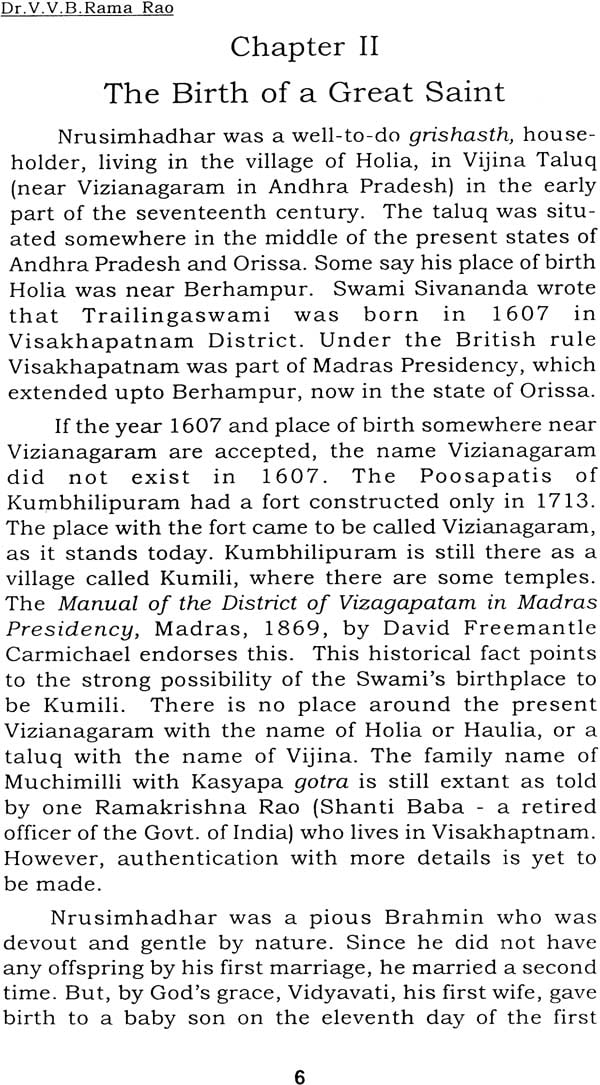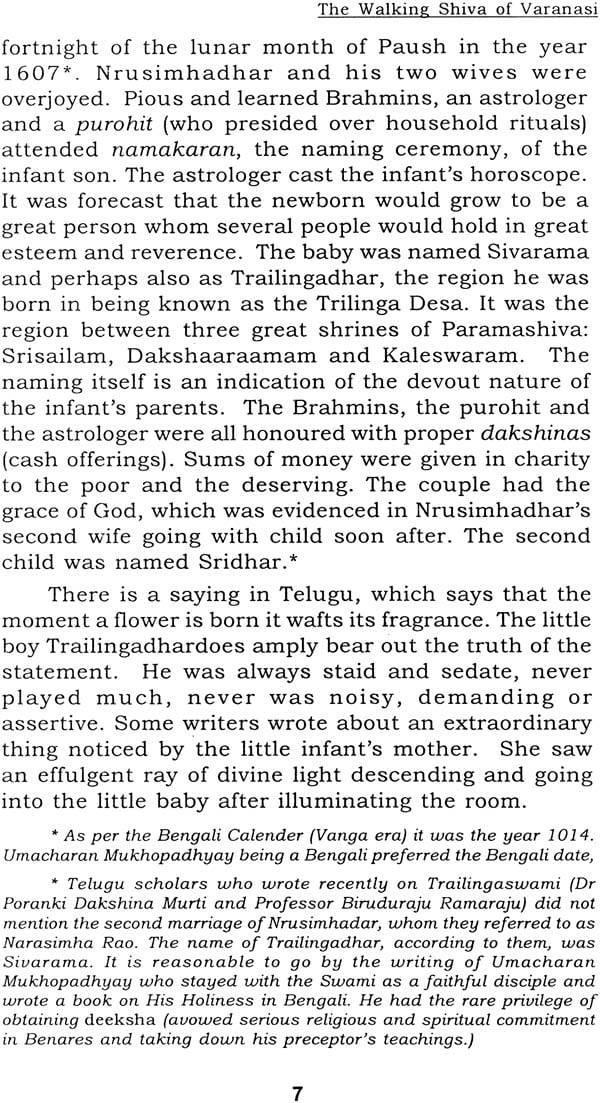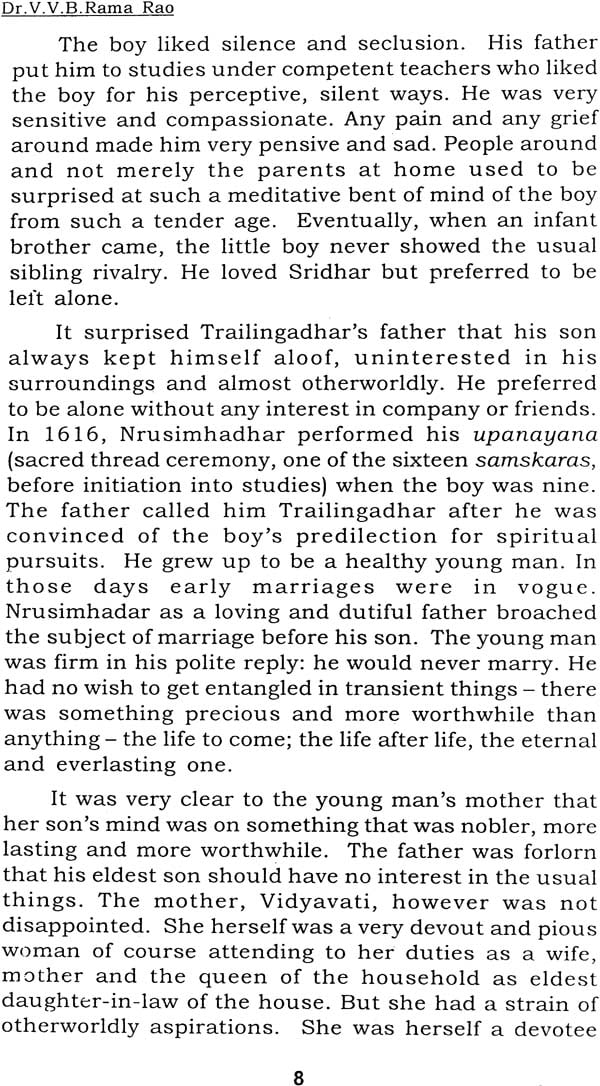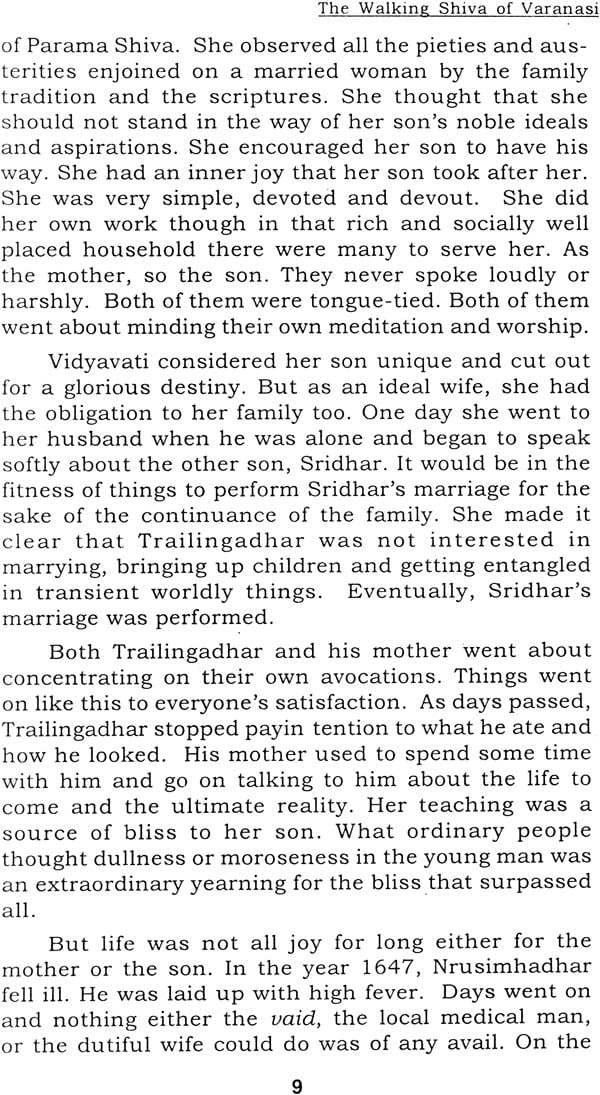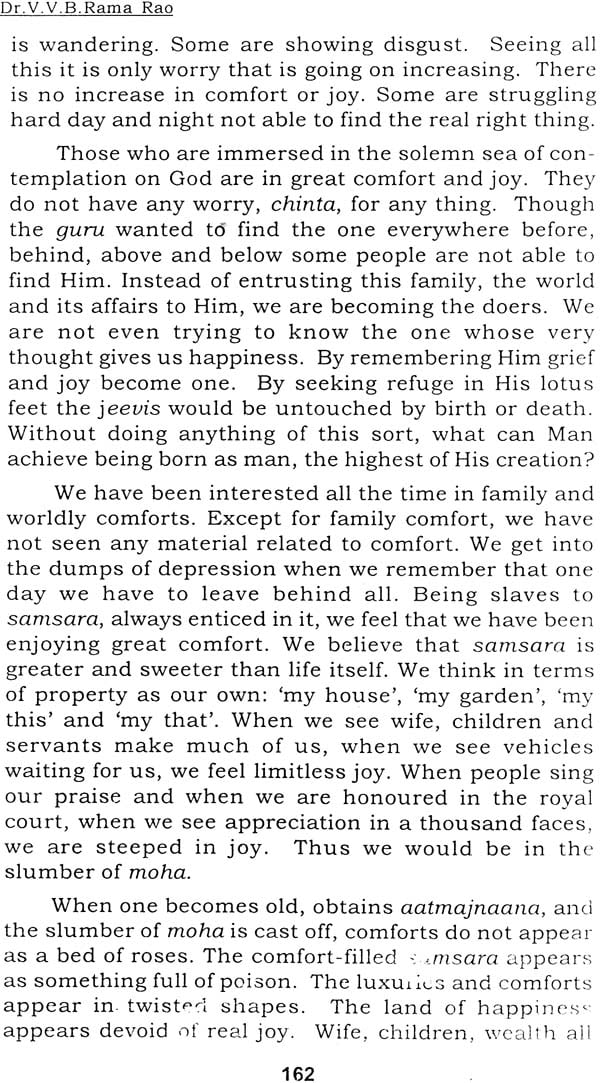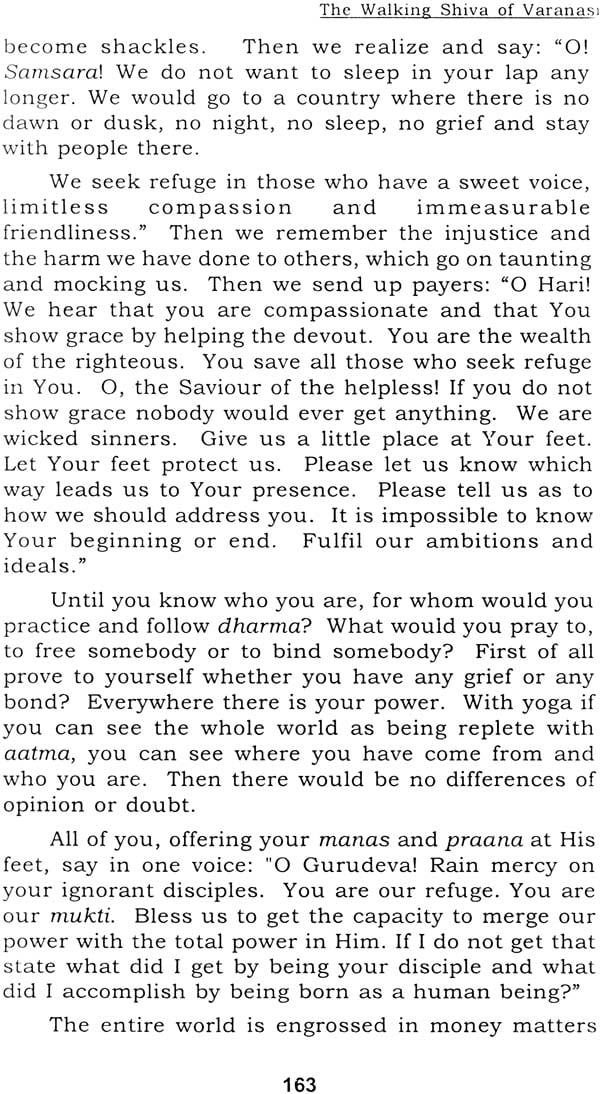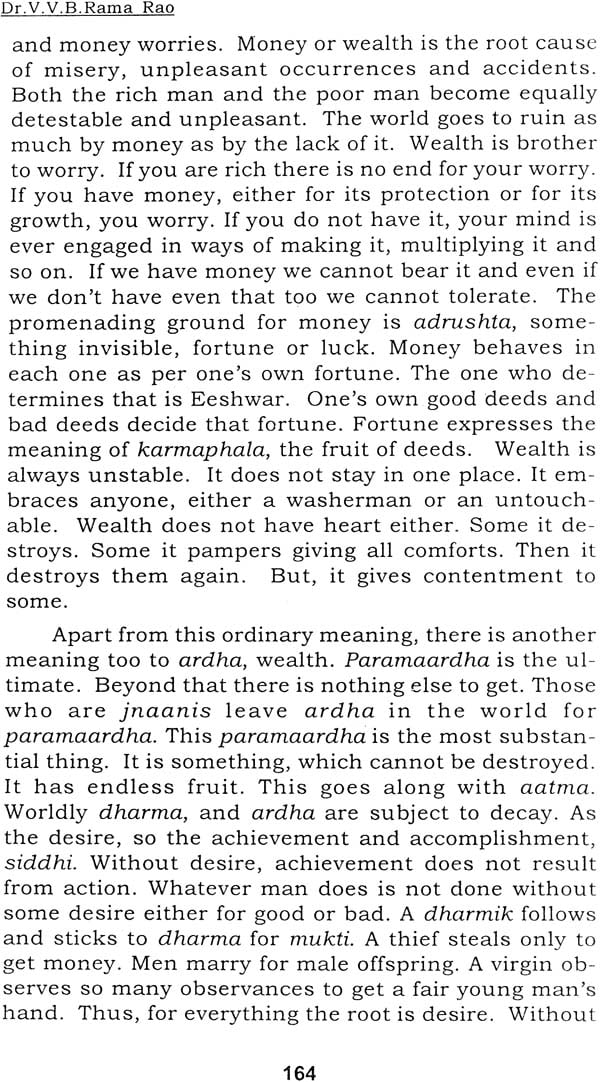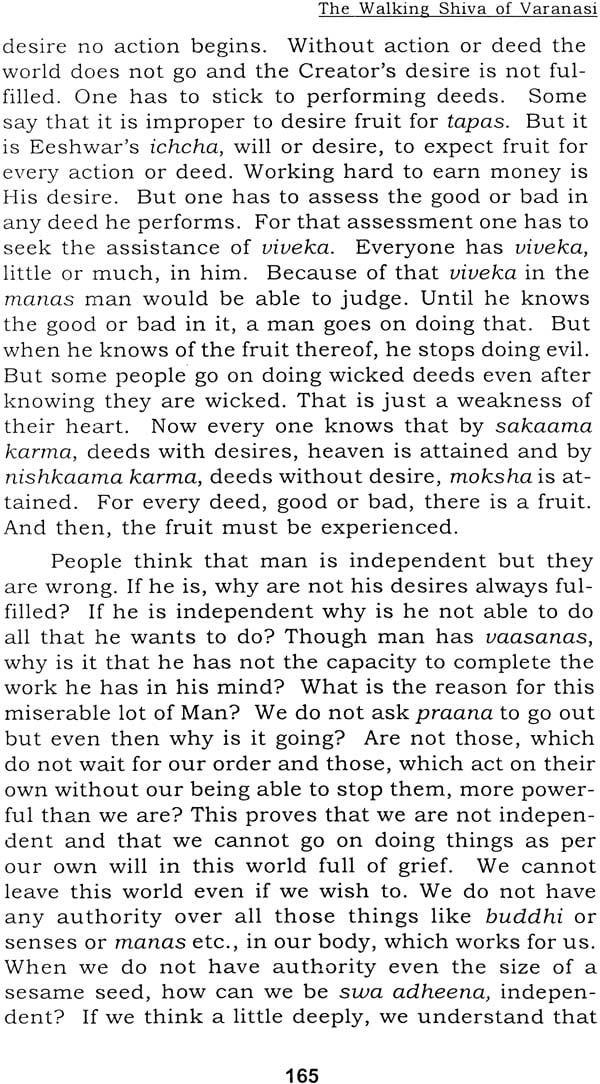
The Walking Shiva of Varanasi
Book Specification
| Item Code: | IDG939 |
| Author: | Dr. V.V.B. Rama Rao |
| Publisher: | Richa Prakashan |
| Edition: | 2004 |
| ISBN: | 8190120085 |
| Pages: | 178 { 8 Line Drawings in B/W} |
| Cover: | Paperback |
| Other Details | 8.5" X 5.5" |
| Weight | 220 gm |
Book Description
Monumental, Brick, mortar and steel could not restrain Him, nor can a wooden casket at the bottom of the Ganges, off the Panchangangaghats in Varanasi. Mahatma Triailingaswami breaks free again out of compassion for His children. Much averse to publicity during is times, this book is a rare feast. His life and teachings come through with chakra piercing force, through the digital din of our times.
During his physical embodiment Paramahamsas sought his satsang. Here is the rare opportunity to drink deep off the fountain of spirituality. A must read for every earnest spiritual seeker groping his way about in this cyber age of truth benumbing distractions.
Selvaraj
V.V.B. Rama Rao (b.1938) retired as Head of the Dept. of English from the renowned Maharajah's College, Vizinagaram (Andhra Pradesh). A Retired ELT expert, he has a lot of published work, thirty books, hundreds of critical essays and reviews to his credit. He writes both in English and Telugu. He is a novelist, short-story writer, biographer and critic. He translated widely from Telugu to English and English to Telugu.
Dr. Rao's publications in the field of spirituality and religion are The Joy of the Divine, summary of discourses on Saundaryalahari and Sundarakaanda in Viswanadha Satyanarayana's Ramayana Kalpavriksha, Durgasaptashati and Shivapuran in English and Lalleshwari Vakkulu in Telugu.
The Walking Shiva of Varanasi is Rao's latest publication. Swami Gokulananda of Ramakrishna Mission, New Delhi, Wrote: Among the great souls and seers who have sanctified the earth of this country, Trailingaswami Maharaj is one of the foremost. His spiritual attainment and his life are legendary. Sri Ramakrishna who met him in Varanasi .. Though one is familiar with the legends about Trailingaswami, there is dearth of dependable literature about his life and teachings. I am happy to find that Dr. Rama Rao's book filled this vacuum.
Sadguru Shri Sivanandamurtygaru, w/hile blessing me to go ahead with my work on Sri Sri Trailingaswami, warned me that the terms relating to Yoga are not easy to translate. The Swami's teaching is replete with yogic terms. There are no exact equivalents for these in English. But every effort is made to give near equivalents in parenthesis, for too many footnotes would be a distraction to the reader and a glossary at the end would be a bother to turn to while eagerly going through the text. Now, the circumstances that prompted me to undertake this work.
Though available in essays and short narratives the information on the Swami is not exhaustive in the sense that his preaching did not receive the attention it deserves. And then it is not available in English. The best and the most relevant part for the contemporary reader would be the Swami's preaching.
The Swami was born in the Telugu region of South India, probably in the area I hail from. He lived for two hundred and eighty years, next only to the Methuselah of the Bible who was supposed to have lived beyond nine hundred. For this reason, I readily accepted to write a full-length book on the Swami and his preaching in English, when an unknown reader of my articles on the web got in touch with me and suggested I write on a yogi for the benefit of Indians abroad. I thought that Mr. Selvaraj's contacting me and suggesting to me a work of this sort was Divine Will.
The Swami lived in Varanasi alone for one and a half centuries. The earlier part of the Swami's life for one hundred and thirty years is dealt with in essays and narratives. The only book with a comprehensive treatment of the subject was the one in Bengali by the Swami's beloved disciple Shri Umacharan Mukhopadhyay, which was published by the Swami's Mutt only in 1983. Dr Vasudeva Chatterjee brought out a Hindi translation. From that a Telugu rendering followed in the year 2003 published by Sanatana Dharma Charitable Trust with the blessings of Sadguru Sri Sivanandamurtygaru of Anandavanam, Bheemunipatnam. I must acknowledge my indebtedness to the good work by all the earlier scholars who undertook the work with devotion and commitment.
The Swami's work has immediate relevance to all of us living in the 215t Century, what with the unrest we experience in all fields, political, social, economic and, more importantly, faith and religion.
Ignorance and a hankering after worldly comforts generate much of the ill will and bad blood. A little reflection on the teachings of the mahatmas down the ages would be a balm providing a release to the tension and mitigating grief. Adjusting our lenses would bring relief to our suffering in many ways. The world now is besieged by war nerves and steeped in violence, poverty and destitution. Indic thought and faith, being the most hoary, holy and sublime, could be our only saviour.
A careful study of the Swami's life and his 'miracles' performed out of limitless compassion would be an eye-opener to all. The Swami's preaching, I believe, was in the form of dictation to his trusted disciple. In the last chapter, the conversational, urging tone, is worth noting.
India has been called the PUNYABHUMI by Swami Vivekananda as she has given birth over the ages to great souls who have not only enriched our religion and culture but also have shown the right path to us whenever there has been a crisis. Among these great souls and seers who have sanctified the country, Trailingaswami Maharaj is one of the foremost. His spiritual attainment and his life are legendary. Sri Ramakrishna who met him in Varanasi has called him "The Walking Shiva of Varanasi". This is also the title aptly chosen by Dr V.V.B. Rama Rao for his book on the Swamiji. Though one is familiar with the legends about Trailingaswami, there was dearth of dependable literature about his life and teachings. I am happy to find that Dr. V.V.B.Rama Rao by his painstaking work has filled this vacuum.
I hope the book will be widely read by my countrymen who will immensely benefit from it.
Bharatakhanda, the land of Bharat, has been the fountainhead of Theism and Spiritualism. These have been the bases of sanatana dharma. Hinduism is not a religion but a way of life, originated in and approved by great seers and sages in aryavarta. This dharma is also known as arsha dharma, derived from the Vedas. We are told by jnaanis, the knowing-ones, all along that this is a way of life. To begin with, living in the earliest of times as an integral part of Nature, respect- ing and adoring, protecting and sustaining her, Man has now come to be reckless. Today Man has brought on himself an imminent threat to his very existence with psychological aberrations, heartless ambition and unholy desire. Against this background, Spiritualism and Theism (our only wealth down the millennia) could be our only saviours.
The lamp of jnaana is essential both for physical welfare and spiritual well-being and the soul's jour- ney upward. When worldly desires and turbulent physical pleasures suffocate the psyche all around and all along, there would come a day when the individual is confronted with questions like 'Who am I?' 'What is the purpose of life?'and 'Does life end with the burn- ing ghat or the crematorium?' Answers to every one of these questions have to be found by the individual all by himself or herself. It is at this juncture that the lives and teachings of our great seers, saints and ma- hatmas help us to find a little light for the mind grop- ing in darkness. Only with a sincere effort we can re- alize the greatness of our forefathers, the seers (drashthas), sants and munis.
It is well nigh impossible to call Trailingaswami either a saint, a siddha, a yogi, a saadhaka, a baba, a paramahamsa, an avadhoota or, an avatar for he is all and not merely one among these many. Nothing could be more presumptuous and preposterous than to think of such a great one as one of these many forms great- ness assumes. It is perhaps for that reason that ma- hatma has been chosen to be an epithet for Trailingaswami. Literally mahatma signifies one who is extraordinarily great, 'maha"atma', great soul. 'Atma' being an amsha, a part and aspect of Paramatma (the Supreme Being), no appellation could be weightier than mahatma.
A politician or even a statesman, sometimes, may abide the question of a rationalist who trusts only in the mind and the capacity to think, analyse and conclude or prove, but a sage or saint is ever free. Saints and their ilk have to be believed and belief is a matter of heart, faith. It is impossible to sum up the accomplishment of a mahatma, for it has many facets, many aspects and many diverse depths of accomplishment. As God can not be forced into a narrow definition, mahatma too can not be circumscribed in the confines of words and a definition. Nevertheless, an attempt could be made to relate some incidents and occurrences that bring out the qualities, accomplishments and depths of the great soul as seen, observed, felt and experienced by his fellow beings.
The sage, seer, yogi, or 'mahatma', has to be approached with a degree of reverence (which is a function of faith), not with a meddling intellect. His miracles belong to the realm of 'adbhut', the wondrous and fabulous, extraordinary events and acts. They strike people with wonder, which automatically produces a joyous suspension of disbelief.
Faith can move mountains and faith it is that can accomplish things apparently impossible. The prayer goes:
mookam karoti vaachaalam pangum langhayite girim yatkrupaa tamaham vande paramaananda To Him, the one who with His grace makes the dumb speak and the lame leap over a mountain, the blissful Madhava, I offer my salutations.
Hinduism is not so much a religion as a way of life. Vedic faith is unique: it believes in universal equality of all living beings. It is the hoariest of religions of the world proclaiming that the inner essence of all living beings is the part of the essence of the Supreme Being.
Here is what Swami Kritarthananda wrote while writing an introduction to His Holiness' short essay on Trailingaswami entitled The Living Shiva of Varanasi:
"Nowhere else in the world is renunciation held in such high esteem as in India. It is but natural. We owe our allegiance to our ancestors who were not kings or barons but renouncing sages. This is our heritage. When people in other parts of the globe were engaged in looting and ransacking each other just to continue the principle of "survival of the fittest', India went on producing sages with positive outlook, sublime thoughts. Such spiritual gems of India silently contributed to the well being of the whole world. They did not do it with war trumpets; they simply lived their authentic lives. They can be likened to the "gentle dew that fails unheard and unseen at night, and brings into blossom the fairest of roses' according to Swami Vivekananda (Complete Works Vol 3. P. 274). He threw down the gauntlet saying, I challenge anybody to show one single period of her national life when India was lacking in spiritual giants.' (Complete Works Vol 4. P. 315)"
| Argument | ix | |
| Author's Preface | x | |
| Foreword by Swami Gokulananda | Xii | |
| 1 | Introduction | 1 |
| 2 | The Birth of a Great Saint | 6 |
| 3 | Powers of a Yogi-Gestures of Grace and Compassion | 12 |
| 4 | The Saint in Kashi- Mauni Baba | 19 |
| 5 | The Saint in Panchgangaghat | 26 |
| 6 | Devotee Umacharan's Experiences | 34 |
| 7 | The Teachings: Guru and Sishya (The Preceptor and the Disciple) | 57 |
| 8 | Chittashuddhi (The Purity of Mind-Will-Motive) | 63 |
| 9 | Dharma (The Holy Order) | 66 |
| 10 | Upaasana (Committed, Continuous, Intense Worship) | 72 |
| 11 | Poorvajanma- Parajanma (Previous Life-After-Life) | 81 |
| 12 | Aatma Bodha (Self-Realizations) | 88 |
| 13 | Tanmayatwam (State of absorption in the Supreme Being) | 93 |
| 14 | Saaroktulu (Pirthy Sayings) | 106 |
| 15 | Tatwajnaana (Knowledge of the Ultimate) | 115 |
| 16 | Eeshwar (The Supreme Being, Param Shiva) | 140 |
| 17 | Srishti (Creation) | 147 |
| 18 | Samsara (Family) | 158 |
| Appendix I | Important Dates | 167 |
| Appendix II | A Note on the History of Telugu and Trilinga Desa | 169 |
| Appendix III, IV. V and VI | Diagrams | 171-174 |
| List of helpful Books | 175 |
